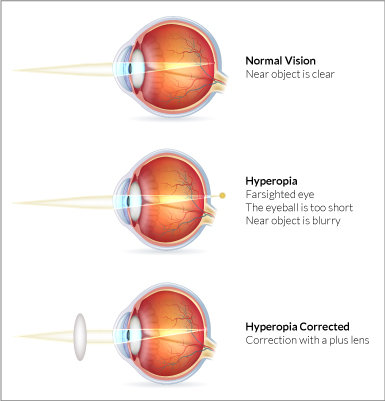Hyperopia
What is hyperopia?Hyperopia, also known as farsightedness, is a common type of refractive error where distant objects may be seen more clearly than objects that are near. However, people experience hyperopia differently. Some people may not notice any problems with their vision, especially when they are young. For people with significant hyperopia, vision can be blurry for objects at any distance, near or far. Causes and Risk FactorsHow does hyperopia develop?Hyperopia develops in eyes that focus images behind the retina instead of on the retina, which can result in blurred vision. This occurs when the eyeball is too short, which prevents incoming light from focusing directly on the retina. It may also be caused by an abnormal shape of the cornea or lens. Who is at risk for hyperopia?Hyperopia can affect both children and adults. People whose parents have hyperopia may also be more likely to get the condition. |
 |
Symptoms and Detection
What are the signs and symptoms of hyperopia?
The symptoms of hyperopia vary from person to person. Your eye care professional can help you understand how the condition affects you. Common signs and symptoms of hyperopia include:
- Headaches
- Eyestrain
- Squinting
- Blurry vision, especially for close objects
How is hyperopia diagnosed?
An eye care professional can diagnose hyperopia and other refractive errors during a comprehensive dilated eye examination. People with this condition often visit their eye care professional with complaints of visual discomfort or blurred vision.
Treatment
How is hyperopia corrected?
Hyperopia can be corrected with eyeglasses, contact lenses, or surgery.
Source: National Eye Institute



